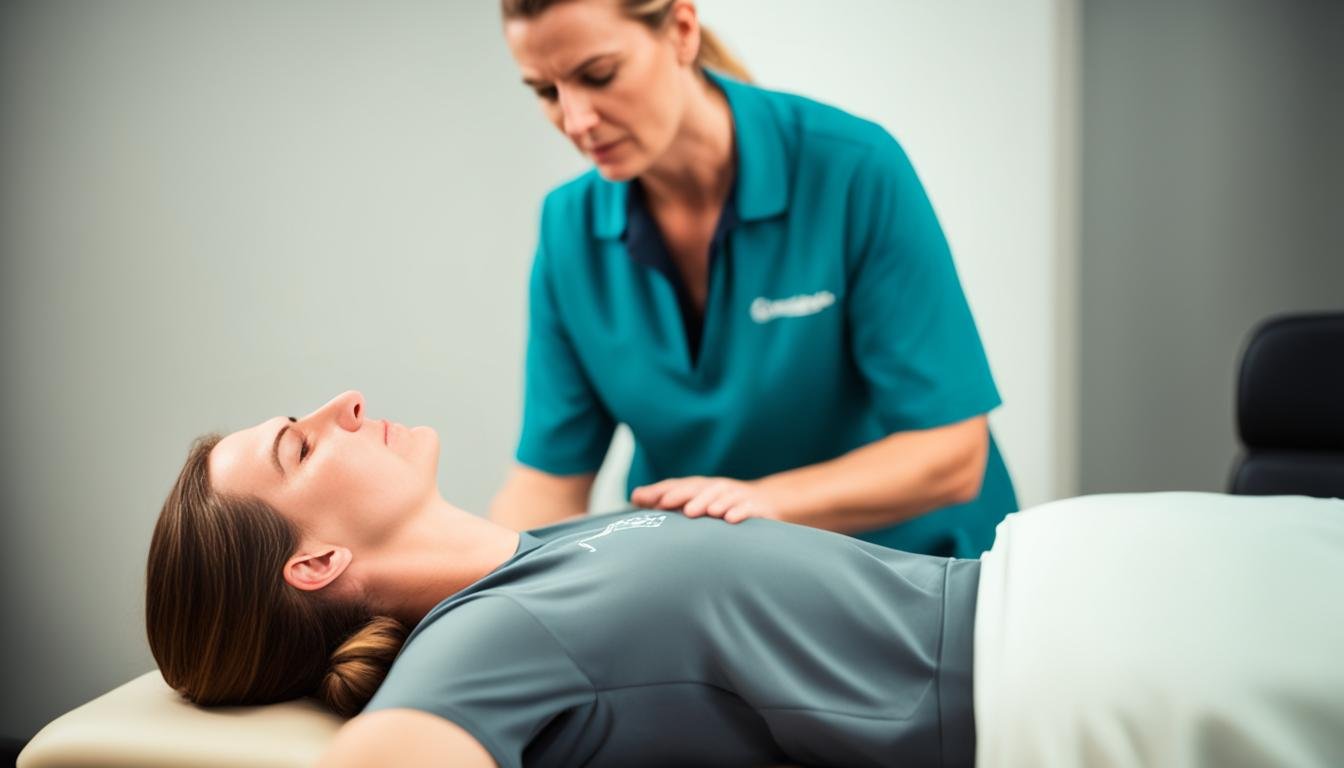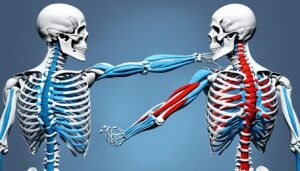Many people love massage for easing both everyday and lasting pain. Deep tissue massage and Swedish massage work deep down to fix your muscles. They help relax your muscles and reduce pain. Massage can really help with lower back pain, muscle tightness, stiff neck, and upper back pain.
But, sometimes, you might feel extra pain or discomfort from the massage. A study from 2013 showed this. 18 out of 100 people felt quite bad after a regular massage. If you think deep tissue massage has to be painful, that’s not true! You’re in charge of your body. So, if it hurts, tell your massage therapist to ease up. They can make changes to make you feel better.
Key Takeaways
- Massage can make your muscles sore after, like after a workout.
- Getting massages regularly can make this soreness less over time.
- Deep tissue massages might make you more sore than lighter ones.
- Talking to your massage therapist is important for a good, comfy massage.
- Some health conditions need a doctor’s okay before getting a massage to avoid issues.
Understanding Post-Massage Soreness
It’s very normal to feel sore after a massage. Moving muscles you don’t use a lot can cause delayed onset muscle soreness. This is all part of getting better as your body heals from the massage-related inflammation. Sometimes, this can happen if your muscles are not used to how they are touched during the massage.
Delayed Onset Muscle Soreness
Just like with a new workout, it takes time for your muscles to adapt to massage. This can lead to delayed onset muscle soreness. It starts 24-48 hours after the massage and can stick with you for a few days.
Inflammation as Part of the Healing Process
Feeling sore tells us that our body is working hard to get better. The massage helps blood flow and gets rid of lactic acid, but it can also cause a little swelling. This swelling is just your body’s way of repairing itself from the massage.
Targeting Underutilized Muscles
After a long time without massage, or if it’s your first time, you might feel extra sore. That’s because your muscles are not used to this kind of touch. But, if you make massage regular, your muscles will learn, and you won’t get as sore.
Reasons for Back Pain After Massage
Neck pain after a massage might mean you’re very tight in that area. Maybe your neck doesn’t move well because you work at a desk. Deep tissue massages could make you sore, especially if you’re sensitive or already in pain. For a more comfortable experience, choose a gentler massage.
Tension and Tightness in the Back Area
If it’s been a while since your last massage or your first time, you may feel sore later. Having massages often helps your muscles remember and not hurt as much.
Limited Flexibility and Mobility
Deep tissue massages can leave you achy. Choosing a lighter massage can prevent this, especially if you’re sensitive or in pain.
First-Time or Infrequent Massage Sessions
After your first or if it’s been a long time, you might be sore. Massages hurt less the more you have because your muscles get used to it.
back pain after massage
Soreness after a massage is normal. But it should only last a day or two. It should not stop you from doing your daily activities. If the pain continues, you must see a doctor.
If during a massage, you feel a sharp pain, then you should stop. And you should contact a doctor right away for help.
Relieving Soreness After a Massage
Soreness from a massage usually goes away in about a day. Here are some things you can do to ease it.
Staying Hydrated
Drink a lot of water after your massage. Stay away from drinks that can make you even more thirsty, like alcohol or caffeine.
Gentle Stretching
Try some gentle stretches when you get home. It can loosen up your muscles and make you feel better.
Heat Therapy
A hot shower or using a heating pad can help. Heat therapy eases muscle pain after a massage.
Essential Oils
Essential oils in a bath or a diffuser can be soothing. They help with inflammation and pain too.
Topical Treatments
Use muscle rubs or CBD lotions on sore spots. They can make you feel better. Massaging the area yourself also helps.
Herbal Remedies
Some herbs like turmeric and ginger might lessen the soreness. It’s always good to check with a doctor before trying new supplements.
Rest and Recovery
Resting is crucial to let your body heal. Try to avoid hard workouts and give your muscles time to recuperate.
Types of Massage and Their Intensity
Massage comes in many types, each unique in its own way. By knowing their differences, you can choose the best one for you. This helps meet your specific needs and likes.
Swedish Massage
Swedish massage is very popular in the West. It’s often called “classic massage.” This type uses gentle, flowing strokes. It’s great for easing muscle tension and promoting relaxation.
It’s perfect if you want a calming experience.
Deep Tissue Massage
Deep tissue massage is different. It uses strong, focused pressure to reach deep muscles. This can help with chronic pain and injuries. Though it may feel sore at first, it’s excellent for healing and reducing swelling.
Trigger Point Massage
Trigger point massage focuses on tight muscle spots. These are known as “trigger points.” It aims to relieve pain and discomfort. This type can help with headaches and back pain, making you feel better.
Communicating with Your Massage Therapist
Talking openly with your massage therapist is key for a good visit. Discuss any worries or needs about your body before you start. This includes telling them if you like light, medium, or firm touch. During the massage, they will ask how you are doing. If something hurts, or if you need less or more pressure, let them know. Massages should not hurt you.
Discussing Pressure Preferences
It’s important to say if you want a certain area softer or firmer. Let your therapist know your preference, like light, medium, or deep. This will make sure the massage is just right for you.
Voicing Concerns and Discomfort
If a massage ever feels bad or painful, speak up right away. Your therapist can change things to make you feel better. It’s important to talk to your therapist to solve any issues as they happen.
Providing Medical History
Share if you have any health problems or injuries with your therapist. This helps them give you a better massage without making things worse. They can adjust their techniques to keep you safe and comfortable.
When to Seek Medical Attention
Feeling sore after a massage is normal. But, it’s vital to know when your pain needs a doctor’s attention. If you have severe or prolonged pain after a massage, see your doctor. This could mean there’s an issue that needs checking or extra care.
Severe or Prolonged Pain
If pain after a massage is very bad or lasts a day or more, and makes it hard to move, call your doctor. Sharp pain during the massage means you should stop and get medical help. It might be a sign of injury.
Potential Underlying Conditions
Does back or neck pain keep coming back after massages? It might be from an old injury or health problem. Talk to your doctor about this. They can find out what’s wrong and suggest the best care.
Contraindications for Massage
Some health issues might make massages risky. It’s key to share your medical past with your massage therapist. Tell them about any old injuries, what meds you’re on, or health issues. This helps make sure your massage won’t do more harm than good.
Massage Therapy and Pain Management
We are experts in easing your pain management and healing your body. At Arizona Pain and Spine Institute, we specialize in treating lower back pain. Our team uses safe and effective massage therapy for pain management.
Have you felt worse after a massage? We can help you get back to feeling good. Call us to improve your quality of life.
Preventing Massage-Related Injuries
It’s crucial that both the client and the massage therapist stay safe. Safety is top priority in massage therapy. It ensures a good time for everyone.
Choosing a Licensed Massage Therapist
Choosing a licensed and experienced massage therapist is crucial. They know how to avoid hurting you. Make sure to check your therapist’s credentials online and in person.
Discussing Goals and Concerns
Before your massage, talk about what you want and any worries. This helps your therapist make the massage just right for you. Tell them about any health issues and how hard you like the massage.
Maintaining Open Communication During Treatment
Talk with your therapist throughout the massage. If anything hurts or feels off, speak up. They’ll make changes to keep you safe and comfy. Keeping things clear is really important.
Conclusion
Back pain after a massage is normal. But, you can do things to feel better. Talk to your massage person about what happened. Also, try different ways to feel good again.
Don’t let the pain stop you from moving. Drink plenty of water, stretch, and use warm things on your back. This helps the muscles get better. Keep talking to the person who massages you. This can help stop problems before they happen.
Moving forward, massages do more good than bad. They help relax your muscles and make you more flexible. By being active and talking to your massage person, you get the most out of each massage. This way, you have less chance of feeling pain and more of the good stuff.




